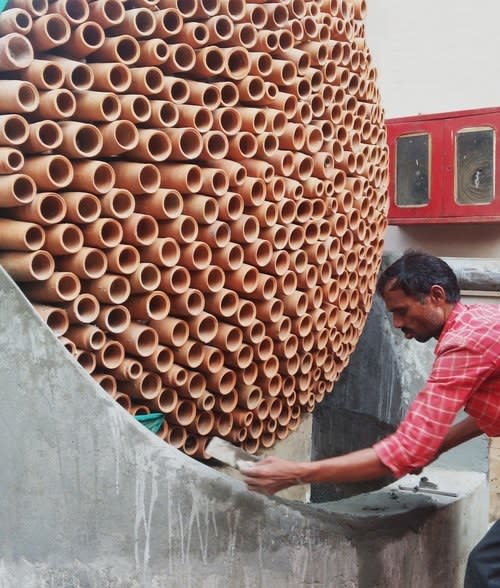This No-Electricity Air Conditioner Could Literally Save Lives
Even before President Trump pulled out of the Paris accords, there’s been ample evidence that climate change could cause devastation throughout the developing world. Look no further than the Indian province of Rajasthan, where temperatures eclipsed 126°F last summer and many lack the resources to keep cool.
That’s why there’s never been a more urgent need for projects like Ant Studio’s no-electricity air conditioning unit. Created by the Indian architecture firm’s founder Monish Siripurapu, the device uses a series of cylindrical terracotta "pipes" and a little help from wind and water to cool down the air of a room. The terracotta is doused in water, and the humid clay then captures some of the heat from the air. In trials of the device, air that was once 122°F passed through the other side at a relatively balmy 96.8°F.
The use of this scientific principle can be traced back to around 3000 BCE, and has its roots in the area around India and Pakistan. Sirpurapu conceives of the device as using techniques of the past to meet the unique demands of the present. “I wanted to find a solution that is ecological and artistic, and at the same time evolves traditional craft methods,' the founder of Ant Studio said.

Though you’d be hard-pressed to describe 98.6°F as comfortable, cooling down oppressive heat without the need for a power source is an impressive feat. Siripurapu estimates an installation cost of $1,850, but eliminating the need for much in the way of maintenance or utilities to keep the system up and running makes it an incredibly cost-effective way to cool down factories and large indoor spaces that have sufficient airflow (or at least a fan).
With many rural and underserved areas in need of sustainable ways to beat the heat, Ant Studios’ solution could be invaluable, especially once they can be reproduced within local communities. Here’s hoping the ingenious and efficient use of resources the project represents can be a model for designers around the world.
